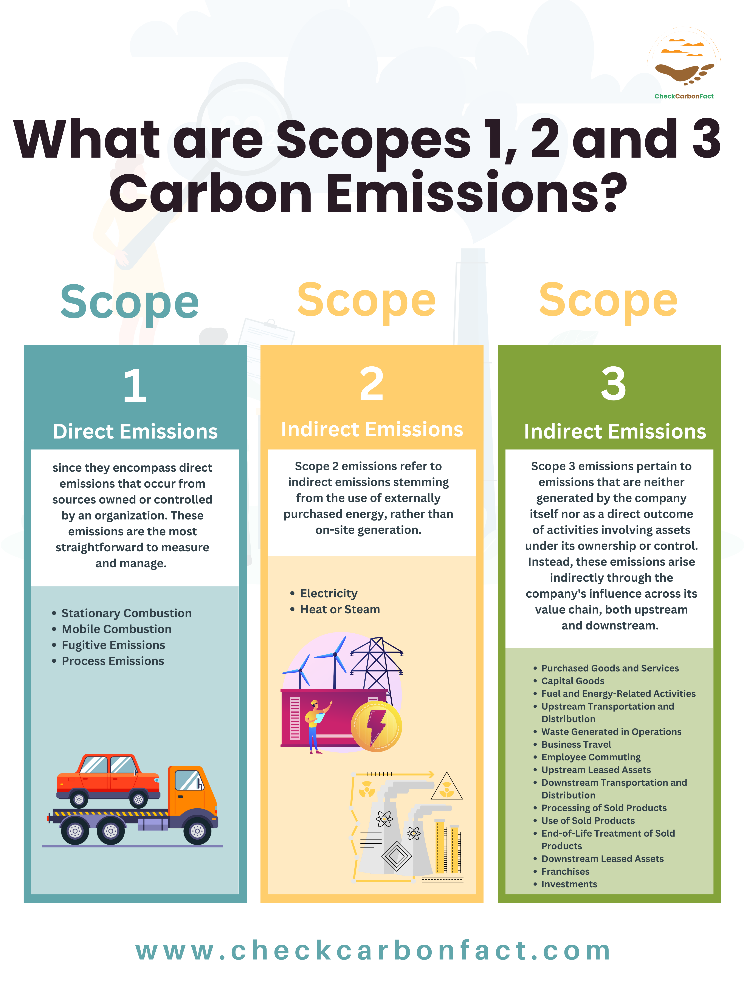Amidst the growing environmental awareness, understanding greenhouse gas emissions is crucial in reducing our carbon footprints, whether as individuals, businesses or public organizations.
To address this and meet up with the Paris Agreement benchmark of keeping global temperatures below 1.5 °C, the Greenhouse Gas Protocol introduced a classification system known as Scopes 1, 2, and 3 emissions to support entities in monitoring their footprint.
The Greenhouse Gas Protocol was launched in 1998, comprising businesses, Non Governmental Organizations (NGOs), governments, and other stakeholders, all coordinated by the World Resources Institute (WRI).
The primary objective of establishing the Greenhouse Gas Protocol is to set international standards to measure and manage emissions.
The GHG Protocol Initiative has two distinct sets of standards; the GHG Protocol Project Quantification Standard and the GHG Protocol Corporate Accounting and Reporting Standard.
The GHG Protocol Corporate Accounting and Reporting Standard offers a step-by-step instructional guide to assist companies in quantifying and reporting their greenhouse gas emissions.
This guide categorises a company’s greenhouse gas emissions into groups referred to as ‘scopes,’ which are known as scope emissions – scope 1 emissions, scope 2 emissions, and scope 3 emissions.
In this blog post, we will delve into what Scopes 1, 2, and 3 emissions are and why they matter.
1. Scope 1 Emissions: Direct Emissions
Scope 1 emissions are the easiest to control since they encompass direct emissions that occur from sources owned or controlled by an organization. These emissions are the most straightforward to measure and manage. They typically fall into four categories, and each of these categories represents a distinct source of greenhouse gas emissions that organizations should consider when quantifying and reporting their carbon footprint:
- Stationary Combustion:
- This category covers emissions resulting from the combustion of fossil fuels, including boilers used for heating buildings and industrial applications, such as gas-fired combined heat and power (CHP) plants.
- Common fuels in this category include natural gas, liquefied petroleum gas, oil, fuel, and propane.
- Biogenic emissions (CO2 emissions from biomass combustion) must be reported separately as Scope 1 Biogenic Emissions. If a company purchases biogas or biomethane through a contractual instrument, it should meet Scope 2 Quality Criteria; otherwise, the gas use should be reported as Scope 1 natural gas.
- Mobile Combustion:
- This category includes greenhouse gas emissions from vehicles owned or leased by an organization, such as cars, trucks, or vans powered by petrol or diesel.
- Electric vehicles (EVs) and plug-in hybrids fall under Scope 2 emissions (indirect emissions).
- Fugitive Emissions:
- Fugitive emissions refer to unintentional leaks of greenhouse gases, particularly from sources like refrigerant gases or air-conditioning units.
- Refrigerants, known as F-gases, are regulated in the EU under the F-gas regulation due to their high global warming potential (GWP), making it essential for organizations to report on these emissions.
- Process Emissions:
- Process emissions constitute the emissions released during industrial processes and on-site manufacturing activities.
- Examples include CO2 emissions from cement manufacturing or the production of chemicals.
2. Scope 2 Emissions: Indirect Emissions
Scope 2 emissions refer to indirect emissions stemming from the use of externally purchased energy, rather than on-site generation.
There are two primary sources of Scope 2 emissions:
- Electricity: This is perhaps the most common source of Scope 2 emissions. It refers to the emissions produced by power plants that generate the electricity an organization purchases and consumes.
- Heat or Steam: Organizations that rely on purchased heat or steam, often from external sources, may also generate Scope 2 emissions. The emissions are associated with the energy production used to provide these services.
Addressing Scope 2 emissions involves understanding the carbon intensity of the energy sources your organization uses and exploring options for cleaner energy procurement.
3. Scope 3 Emissions: Indirect Value Chain Emissions
Scope 3 emissions pertain to emissions that are neither generated by the company itself nor as a direct outcome of activities involving assets under its ownership or control. Instead, these emissions arise indirectly through the company’s influence across its value chain, both upstream and downstream.
An illustrative example is the emissions associated with the acquisition, utilization, and disposal of products obtained from suppliers.
Essentially, Scope 3 emissions encompass all sources beyond the purview of Scope 1 and 2 boundaries, making them notably challenging to quantify since they often involve activities not directly linked to the company’s operations.
These emissions are the most extensive and intricate to manage because they encompass all other indirect emissions stemming from the company’s activities but occurring beyond its immediate operational sphere.
They traverse the entirety of the value chain, spanning from the extraction of raw materials to the disposal of products at the end of their lifecycle.
Scope 3 emissions can be further divided into 15 distinct categories, each addressing a specific aspect of indirect emissions.
- Purchased Goods and Services
- Capital Goods
- Fuel and Energy-Related Activities
- Upstream Transportation and Distribution
- Waste Generated in Operations
- Business Travel
- Employee Commuting
- Upstream Leased Assets
- Downstream Transportation and Distribution
- Processing of Sold Products
- Use of Sold Products
- End-of-Life Treatment of Sold Products
- Downstream Leased Assets
- Franchises
- Investments
Conclusion
Understanding Scopes 1, 2, and 3 emissions is essential for any organization committed to sustainability and reducing its carbon footprint. By categorizing emissions in this way, businesses can identify where their greatest impact lies and develop targeted strategies to mitigate their greenhouse gas emissions.
As an individual, you too can take action towards reducing your carbon footprint
Found it interesting and would like more in the mail?




